|
|

Chip Ford's 1974 Catalina 22
Restoration Project
Sail #3282 l Marblehead, Massachusetts |
|
The never-ending project to fill my hole in
the ocean while bailing it out
Safety Equipment Aboard Chip Ahoy
|
I do most of my sailing singlehanded and take
distance cruises alone each season for two or three weeks.
I usually have Chip Ahoy a couple of miles offshore for long stretches,
frequently four, five or more. Personal
safety is an important consideration for me, as is always being prepared
for the worst-case scenario. As the saying goes with firearms,
"It's better to have and not need than need and not have."
|
| Click
thumbnails for a larger picture |
Description |
 |
"The ICOM M302G fixed-mount marine radio is equipped with
a speaker that has a high sound pressure level for a loud and clear
reception and a microphone that's tuned to pick up voice, while reducing
ambient noise. The wide, backlit LCD shows large channel numbers and
channel names of up to 10 characters and the built-in DSC capability
allows you to send a formatted distress message in an emergency."
After my M402 was fried in
a lightning strike, I replaced it with this one. It also
connects through a power/data cable to either of my Garmin GPSMap 76 handhelds
(below) for a functioning DSC switch. When activated this sends
out a continuous distress signal including location coordinates. |
 |
"The
GPSMAP 478 is the ultimate offshore portable GPS/Chartplotter out
there. This unit provides boaters with built-in marine detail
charts of the United States coastline ... easy to read 3.8” diagonal
sunlight viewable TFT screen, which has a 480 x 320 pixel resolution and
256-colors.... comes with a 12-channel, WAAS enabled, adjustable antenna
to get the accuracy of your position down to 10 feet. All of this
is powered by a rechargeable lithium-ion battery that offers a life of
up to 15 hours of use (4 hours when using the GXM 30 and 15 hours
without it). It comes preloaded with Garmin’s new BlueChart® g2
technology.
"The GPSMAP 478 is also equipped with XM Radio and Weather and Audio
capability ... with the optional GXM 30 accessory." Connected
to the VHF radio (above) it complements the radio's emergency
DSC
function, providing the exact location if distress call is broadcast. |
 |
Garmin
GPSMap 76CS: 115 MB
handheld marine GPS with
256-Color TFT Display: "A state-of-the-art handheld marine GPS unit
with a vivid, sunlight-readable color display, sizeable internal memory,
and fast USB connectivity. Central to the device is its high-resolution,
highly reflective, 256-color TFT display and LED backlight, implemented
so you can navigate in either broad daylight or complete darkness."
I use this for a backup. It's loaded with Garmin's detailed BlueCharts
(three "unlocked" regions)
installed for the New England coast from Long Island Sound and Cape Cod, to almost the Canadian border. |
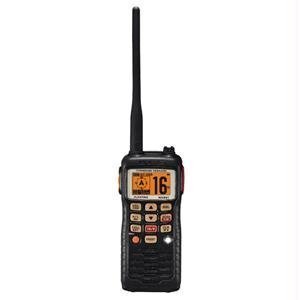 |
My
Standard Horizon HX851 6W Floating VHF w/Glow in The Dark. This
handheld clips to my belt. I've
attached a lanyard which also attaches to my belt, or anywhere else,
to keep from losing it, though it's supposed to float and be waterproof. It has a built-in Lithium-Ion rechargeable battery
(and an optional tray for alkaline batteries),
and comes with both AC and DC charging adapters and cradle. "The
toughest floating handheld radio features 6W, built-in 12-channel GPS
with easy waypoint navigation and compass; DSC distress calling. Glow
gaskets, key illumination." |
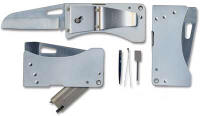 |
Always in my pocket when aboard is a
SOG-SSAC75
with its serrated edge blade: "All stainless construction, the uniquely
sculpted 2.7" (straight or serrated) blade opens swiftly and smoothly
with one-hand and is securely locked into place with SOG's revolutionary
new Arc-Lock™, one-hand opening and closing. The Arc-Lock™ features fast
and secure spring-action opening and closing. It also provides positive
'full lockup' for added strength and safety, so you can be assured this
multi-use blade will be able to withstand those challenging daily tasks.
Includes tweezers, toothpick and straight pin. Pocket/money clip and
lanyard hole." I keep a lanyard attached to its hole and to my belt. |
 |
The handheld VHF radio and my SOG knife are each attached
to my belt or somewhere on my person by a lanyard, so they can't fall
overboard or get lost. When I'm aboard they're always within
reach. The new Personal Locator Beacon (further below) came with its own
lanyard. |
 |
Mounted in its bracket on the starboard stern pulpit rail
is the throwable lifering. I added 60 feet of polypropylene
floatable line to it, attached by a carabineer for quick release.
The line is dual-purpose and doubles as a tow-line dragged behind the
boat in rough weather while singlehanding. |
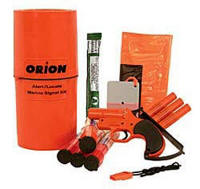 |
My Orion 12 Gauge High Performance Alert/Locate Signaling
Kit #540 contains: The 12-Gauge "Safety Launcher" flare gun with 4 cartridges
(3 red/1 white meteors) and shell retaining bandolier - shoots 500 ft
high, burns up to 7 seconds; 3 Handheld Red Signal Flares - burns at 700
candela for up to 3 minutes; 1 Handheld Orange Smoke Signal - 1 minute
burn time; Distress Flag - 3 sq ft; a SOLAS Approved Whistle with
Lanyard; a Signal Mirror; and a Chemiluminescent lightstick - 12 hr
illumination, all contained in a heavy duty waterproof floating storage
canister. I bought it the first year I put Chip Ahoy in the water,
2003, and have replaced the flares once. I keep the outdated
flares aboard in an air-tight plastic bag as backups. |
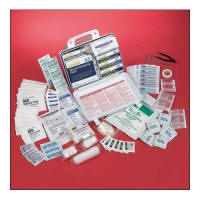 |
My Orion Cruiser First Aid Kit Model CRK contains: 50
(3/4" x 3") adhesive strips, 2 eye patches, 10 alcohol pads, 3 ammonia
inhalants, 1 (1/2" x 10 yds.) cloth tape, cold pack, 2" conforming
gauze, sterile cotton, eyewash solution, first aid cream, first aid
guide, forceps, 2 (4" x 4") gauze pads, 2 (3" x 3") gauze sponges,
motion sickness tablets, non-aspirin tablets, scissors, sting relief
pads, zinc oxide and sunscreen towelettes. I also have a few Ace
bandages in various widths, additional stretch wraps, gauze pads, and
Bandaids. Along with a bottle of OTC Tylenol there's another with
prescription painkiller Tylenol 3 just in case. |
 |
Falcon Signal Horn, for which I have a couple spare
refill cannisters. |
 |
Bushnell 12x42 H2O Waterproof/Fogproof Binoculars. |
 |
I keep a MarinePro 2 million
candlepower spotlight aboard. "This
powerful, rechargeable spotlight can penetrate rain, fog or smoke with
its 100 watt Quartz Halogen bulb. It can run continuously for 20 minutes
while operating cordless, or it can be powered directly from a cigarette
lighter socket. A 110-volt adapter for your home and 12-volt adapter for
your vehicle are included for battery recharging." It's come
in handy a couple of time when pulling into a strange harbor after dark
-- like Plymouth with its long, narrow, winding entrance channel. |
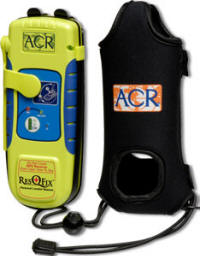 |
The new PLB I ordered arrived yesterday. In
2005 I rented
an EPIRB in a Pelican case from the
BoatUS Safety Foundation for my extended Maine
cruise. I planned to do so again for my upcoming
cruise this summer back up the coast. Instead, I decided to invest
in one of my own rather than pay another $120 (3 weeks) rental charge
plus shipping each season with nothing to show for it after. I chose the ACR ResQFix 406 GPS
Personal Locator Beacon for its size and the fact that it can be carried
on my person, clipped to my belt or lifevest -- always handy, within
reach. (Apr. 4, 2008) --
More details --
(PDF file) -- |
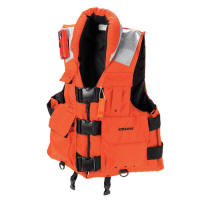 |
I
decided to buy another PFD --
fabric and flotation, not inflatable, with lots of pockets and a place to attach the locator beacon
(in place of the strobe light pictured on the left): a Type III
Stearns SAR
Vest. I'll still use my
SOSpenders inflatable
vest under normal conditions, but if things get dicey I'll switch
over to this new vest, store the handheld VHF, knife, and whatever else
I may need in the pockets. It being fabric and foam, the potential
of puncturing an inflatable bladder is eliminated. |
 |
Since the new vest (above) doesn't have a built-in safety harness
like the inflatable, I picked one up yesterday to complement it, what
West Marine calls its "Ultimate Safety Harness." I'll attach my
strobe light to it instead of to the vest. My current harness
tether (below) is interchangeable, so I can just switch it over. (Apr. 7,
2008) |
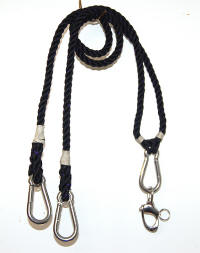 |
My handmade safety harness teether is constructed of
1/2" braided nylon line, spliced and whipped at the splices.
It attaches to the safety harness D rings in its center. Each end
is arm's length.
Three
carabineers make up the attachment points. A snap shackle is
attached to the center carabineer for emergency quick-release under load from the
safety harness if necessary. |
 |
I replaced my vintage ACR/733 barrel strobe light (circa 1978,
purchased while living
aboard the Idle Hours II) with a new
ACR Firefly 3, which will strap on either the life vest or safety
harness, or attach with velcro. It's a bit smaller than the old
733, which takes one D alkaline battery. The 733 is noticeably
heavier than this Firefly 3 with its two AA Lithium batteries, which are
lighter than alkaline batteries to begin with and supposedly good for
five years. (Apr. 8. 2008) |
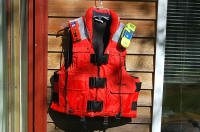 |
The new Stearns SAR vest with PLB and strobe light
fastened by Velcro, ready to load aboard for the season. I love
the pockets. I keep the PLB in one, the strobe light in the other,
where they're easily reachable if I need them. Pull them out and
stick them to the Velcro. Each has a tether with a clip on its end
which attaches to the vest's two built-in rings. (May 29, 2008) |
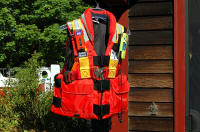 |
The vest with the new safety harness over it. If
I'm using it, the PLB and strobe light will attach instead to the
harness with its own Velcro patches. |
 |
While
replacing the scupper drains frozen ball valve, considering the ball valve's
actual purpose, I decided
what's really needed is a way to plug the hole in the bottom of the hull
if something goes wrong with it. When I came upon the
Forespar
Truplug I thought it is the perfect solution, ordered one for $19.95. |
|
Back to Safety Aboard
| Back to Page 47 |
|
It's never-ending ... so onward and forward to Sailing Season '08! |
 |
|